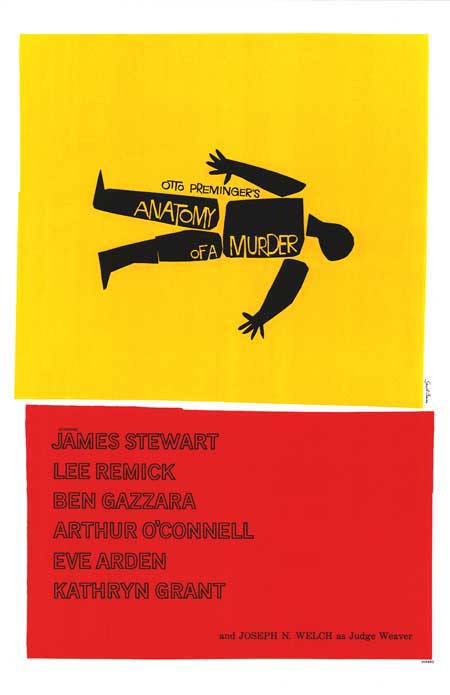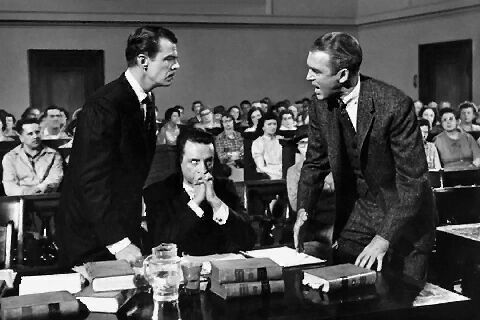
I decided to watch Anatomy of a Murder when I found out that Duke Ellington did the score for it. The music is incredible, but more interestingly, the choice of Ellington and what his music accomplishes is a near perfect symbolic reflection for Otto Preminger’s masterful courtroom drama. Ellington’s compositions are full of subtlety with an eerie tension below the surface that echoes the ambiguity of the movie. Most of the tunes, on the superficial level are upbeat and enjoyable, but upon closer listening one hears disparate voices playing against each other turning the enjoyable toe tappers into ruminations on something more sinister. In much the same way, the viewers of Anatomy of a Murder find themselves rooting for Jimmy Stewart’s defense attorney character to exonerate the admitted killer he is representing.
Much was made at the time of the movie’s 1959 release for the frankness in which the rape of a young woman is discussed. The movie was widely criticized by morality types as being vulgar and inappropriate. I read that even James Stewart’s dad took out a full-page ad in the local paper urging people not to see the movie. For a modern audience that routinely sees and hears much worse on TV police procedurals, these references are shocking with regard to what we know about nice old black and white movies from the era of the Hays Code.
However, more interesting than most procedurals, the viewer is never shown the murder. Instead, the viewer sees events unfold from Jimmy Stewart’s perspective. Stewart is in virtually every scene of the movie. We’re there with Stewart as he discovers the case, interviews the principals, researches case law, and ultimately represents his client at trial. The consequence of this limited point of view is that the viewer never knows THE TRUTH; instead we are left to sort out who and what we believe in much the way that the jury must ultimately decide the case. Stewart even cautions the victim’s daughter at one point that no one is ever all good or all bad, but that most people have the capability be both at different times. Sterling Stewart is even guilty of coaching his witnesses to some extent, a practice which is illegal.

Anatomy of a Murder is full of sly misdirection. The big one I mentioned at the top - that nagging feeling that maybe the suspect should not get off the hook while you can’t help but cheer that Stewart wins the case… we like Jimmy Stewart intrinsically as Americans, but also because he is the underdog in this story facing up against George C. Scott’s big-city prosecutor. The movie asks questions like a lawyer in cross-examination: Is murder justified ever? Is murder justified in retaliation of the rape of a loved one? Even if that retaliation happens several hours after what we would consider to be in the heat of the moment? If there is no legal justification, is there a moral justification? Is it OK to cheat if the other guys are doing it worse? What’s the line between omission and a lie? Is it OK to lie to achieve justice? Preminger poses these questions very directly but does not give any easy answers. When the jury is making their final deliberation on the trial, Stewart’s partner, portrayed by Arthur O’Connell, waxes poetic about the nature of juries – that it is amazing that 12 completely different people can come together and form a consensus about something as complex and challenging as a modern criminal trial, saying that most juries end up being right in their verdicts and hoping that this one is too. He never does say if “right” is guilty or not guilty (by reason of insanity). Of course he wants a not guilty verdict because a big win means that he and Stewart will be able to open a proper law firm. I’m never convinced that Stewart believes that his client is not guilty, morally justified maybe, but not innocent.

All this is of course to say nothing of the great supporting cast, the sexually charged undercurrent of the movie, or seeing General Patton face off against Mr. Smith in the court room. The cinematography was quite good – walking a line between realistic and stylized noir. The movie is in black and white which was becoming increasingly rare by 1959, it does well to portray the pretty Michigan resort town the movie takes place in as an uglier seedier place. Also, Sir Duke makes a cameo playing piano side by side with Jimmy Stewart. While the sexual taboos that made this movie so controversial in 1959 are extremely tame by today’s standards, the story itself holds up remarkably well and is relevant still today. This is a message-less message movie that like Ellington’s music plays on our expectations to deliver us to a stranger and richer place. Highly recommended.